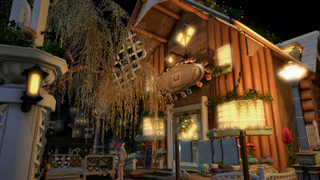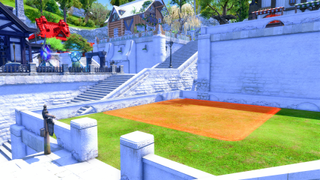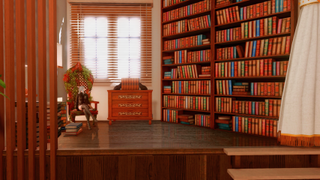How to unlock and buy houses and apartments in Final Fantasy 14
Raise the roof by being the best homeowner in all of Eorzea.

Final Fantasy 14's housing system is a strange one and figuring out where to start can be a complicated affair. If you've spent enough time in the game sitting on a small mountain of gil and unsure where to spend it, buying a house might be the perfect way to spend some coin and have a gorgeous hangout spot to show for it.
With the entire housing system changing in Patch 6.1, the endless placard-clicking of real estate's past is no more. Things are a little simpler now, but there are still a few things to keep in mind with how it all works. Here's everything you need to know about snagging a house in Final Fantasy 14, from unlocking residential wards to plot prices.
Final Fantasy 14's housing system explained
The housing system in Final Fantasy 14 currently consists of five residential areas, each with 24 wards containing 60 plots and two apartment buildings with 90 rooms each. None of these housing plots is instanced, meaning you're able to walk through each ward and see people's houses like a real neighbourhood. The downside to this level of immersion is that housing is incredibly limited. Empty plots get snapped up in a heartbeat and demand very much outweighs the supply.
A recent change implemented in Patch 6.1 has also placed restrictions on who can purchase property per ward. Wards one to nine are reserved exclusively for Free Company housing, while plots on wards 10 to 24 can only be purchased for personal use. Don't worry if you own a Free Company house on ward 15 for example—current owners are grandfathered in.
How to unlock each housing district
There are five different residential districts dotted around the world: lush Lavender Beds near Gridania, seaside residence Mist near Limsa Lominsa, carved-out desert canyon The Goblet near Ul'dah, Far Eastern settlement Shirogane near Kugane and frosty gothic Empyreum near Ishgard. You'll need to do a quick quest in each area to unlock its respective housing ward, as seen below:
- Lavender Beds: Complete the level 10 quest Where the Heart Is (The Lavender Beds), given by Margeria at Bentbranch Meadows in Central Shroud.
- Goblet: Complete the level 10 quest Where the Heart Is (The Goblet) by speaking to Imme at Scorpion Crossing in Western Thanalan.
- Mist: Complete the level 10 quest Where the Heart Is (Mist) by speaking to Ahctkoen at the Red Rooster Stead in Lower La Noscea.
- Shirogane: Complete the level 61 quest I Dream of Shirogane, given by Tsurubami in Kugane. You need to have reached the Stormblood expansion to unlock this area.
- Empyreum: Complete the level 60 quest Ascending to Empyreum given by Gondelimbaud next to the Foundation aetheryte. You need to have completed the majority of the Heavensward expansion to unlock this area.

Each housing type in Final Fantasy 14
There are a few different types of housing available in Final Fantasy 14, from single rooms to entire mansions. To be eligible to purchase personal houses and apartments, you need at least one class at level 50 and to be the rank of second lieutenant in your grand company.
For Free Company houses, the FC must be at least rank six with four active members. You also must be authorised by the Free Company to buy land and also have been a member of that Free Company for at least 30 days.
PC Gamer Newsletter
Sign up to get the best content of the week, and great gaming deals, as picked by the editors.
Each plot type is as follows:
- Apartments: A small, single room that costs 500,000 gil. Apartments can only be purchased for personal use, not by Free Companies. You can own an apartment alongside owning a house and Free Company private chambers. Apartments are plentiful with a few thousand available per ward, so your chances of getting one are incredibly high. They have a furniture limit of 100 items.
- Small plot: A cosy two-storey cottage with a garden that has a 20-item outdoor furniture limit with the option for one garden patch. The price you'll pay varies depending on how desirable the plot's location is, varying from 3,000,000 to 3,750,000 gil. Small plots come with an indoor furniture limit of 200 items. There are 40 small plots available per ward.
- Medium plot: Three storeys and around twice the size of a small cottage. There are 14 of these available per ward, costing between 16,000,000 and 20,000,000 gil. Medium plots have an indoor furniture limit of 300 items and 30 items for outdoor furnishing that can have two garden patches.
- Large plot: The biggest, most expensive and most desirable of them all. Large plots are still three storeys but are significantly larger than medium plots, both inside and outside. There are only six of these available per ward, costing an eye-watering 40,000,000 to 50,000,000 gil depending on the location. These can have 400 pieces of furniture indoors and 40 outdoors as well as three garden patches.
- Private chambers: Practically identical to an apartment, except these are rooms purchased from within a Free Company house. They're the same size as an apartment with the same furniture limit but cost only 300,000 gil. You can own one of these alongside an apartment and house. If you leave your Free Company, you'll lose your private chambers.

How to enter the housing lottery
Congratulations! You've decided you want to enter Final Fantasy 14's housing market, picked your free plot and got your gil ready to throw at it. Now, here's where things have recently changed.
Before Patch 6.1, open housing plots had an invisible timer for when they'd become available for purchase. There was no telling when this invisible timer would lift, leaving you to endlessly click on the placard for hours on end hoping that you'd attempt to purchase it the exact second the timer ran out. It was awful—trust me, I spent nine hours on New Years' Eve 2021 doing this—but that method is no more.
Now, all housing is handled through a lottery. All you need to do is head over to whichever free plot you intend to purchase, click on the placard outside and enter the lottery. Remember, plots one to nine are for Free Companies only, while plots 10 to 24 are for private buyers only. You'll need to deposit your gil there and then, but don't worry, you'll get it back if you're not selected as the winner.
You can only place a bid on one plot per lottery cycle and you cannot apply for both a Free Company and private plot simultaneously. You also cannot withdraw from a housing lottery once you've entered it, so make sure you've chosen carefully before depositing your gil.
That's it! That's all you have to do and now, the waiting game begins. Each lottery cycle lasts a total of nine days: five days for players to submit their lottery entries and a further four days for players to confirm the results and finalise purchases. You can see which stage the lottery is in from the Timers option in the Duty menu.
How do I know if I've won or lost the lottery?
Once the four-day results period has commenced, head back to the plot you bid on. The placard will tell you which number is the winner, confirming whether or not you have won the lottery.
If you've won, congratulations! Simply finalise the purchase from the placard. If you fail to finalise the purchase within the results period or decide you no longer want the plot, you will only be refunded 50% of the gil deposited during the entry phase. If you're buying a Free Company house and several members have won multiple plots, you will need to choose only one. Any others will be subject to the 50% refund policy.
If you've lost, bad luck. Make sure you return to the placard in order to retrieve your deposit, which will be paid back to you in its entirety. The game will only hold onto your deposit for 90 days though, so make sure you accept your refund within the allotted time or you'll lose all your hard-earned gil. You can then place a bid on another empty housing plot during the next lottery cycle.

What if I want to relocate or demolish my house?
While Final Fantasy 14 used to let you freely relocate to open plots regardless of the aforementioned invisible timer, that's no longer the case. If you wish to relocate, you'll need to cough up the gil and place a bid on your desired plot along with everyone else. If you win and choose to relocate, you'll receive a reimbursement equalling approximately 15% of the value of your old plot. Furnishings from your old house will be placed in your storeroom and its capacity temporarily increased to 400 indoor slots and 40 outdoor slots to accommodate that.
If you wish to demolish your house, head to Housing from the Social menu, click on Estate Settings, then pick the estate you wish to demolish. You'll then want to select Relinquish Land. You'll need to clear out the house before you can do this and you won't receive any sort of gil compensation for demolishing your home.
There is also an auto-demolition timer to watch out for. For private houses, failing to access your house for 45 days will result in the game automatically relinquishing your property. For Free Company houses, it will be demolished if no member accesses it for 45 days.
Currently, the auto-demolition timer has been deactivated since December 2021, meaning you can take an extended break without having to worry about your house vanishing. When Square Enix eventually reactivates the timer, it will pick up from how many days you were inactive prior to the timer being disabled.

Mollie spent her early childhood deeply invested in games like Killer Instinct, Toontown and Audition Online, which continue to form the pillars of her personality today. She joined PC Gamer in 2020 as a news writer and now lends her expertise to write a wealth of features, guides and reviews with a dash of chaos. She can often be found causing mischief in Final Fantasy 14, using those experiences to write neat things about her favourite MMO. When she's not staring at her bunny girl she can be found sweating out rhythm games, pretending to be good at fighting games or spending far too much money at her local arcade.

Final Fantasy 16 isn't on PC yet, but you can get the full Clive experience in FF14 right now by wearing his clothes and riding his dog, via the new crossover event

Final Fantasy 14: Dawntrail is having server queue issues months before it's even out, as Square Enix's online store crashes under the weight of pre-orders
Most Popular

